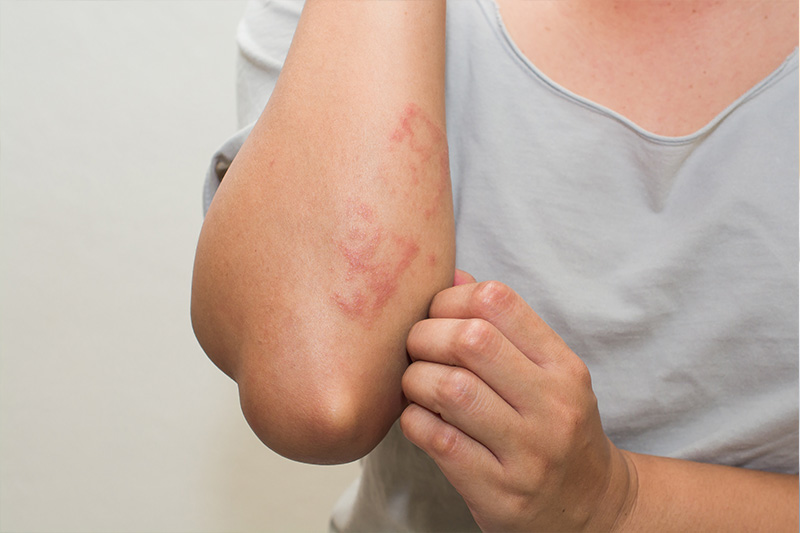Skin Disorders
Skin disorders may vary significantly in severity and symptoms. They may be permanent or temporary, and maybe painful or painless. Some may be genetic, while others may be situational. Certain skin disorders are minor, and others can be life-threatening.
Types of Skin disorders
Acne
- Acne usually happens on the face, shoulders, neck chest, and upper back
- Breakouts on the skin comprising of pimples, blackheads, whiteheads, or deep, painful nodules and cysts
- Acne may darken or leave scars if the skin is untreated
Cold Sores
- Red, painful, fluid-filled blister that appears close to the mouth and lips.
- The affected area will usually burn or tingle before the pain is visible.
- Outbreaks may also be associated with mild flu-like symptoms such as low fever, body aches, and swollen lymph nodes.
Rosacea
- A chronic skin disease which goes through a cycle of fading and relapse
- Sunlight, stress, alcoholic beverages may trigger relapses
- spicy foods, and the intestinal bacteria Helicobacter pylori
- Symptoms include facial flushing, facial redness, raised red bumps, skin dryness, and skin sensitivity
Carbuncle
- Red, painful, and irritated lump under the skin
- Body aches, fatigue and fever, can accompany it
- Can cause skin crustiness or oozing
Eczema
- White scaly or yellow patches that flake off
- Affected areas may be itchy, greasy, oily or red
- Hair loss may happen in the area where the rash is present
Psoriasis
- Silvery, scaly sharply defined skin patches
- Usually located on the scalp, elbows, knees, or lower back
- Can be itchy or asymptomatic
Impetigo
- Found in babies and children
- Rash is usually located in the area around the nose, mouth and chin
- Fluid-filled blisters and irritating rash that pop easily and form a honey-coloured crust
Ringworm
- Circular scaly rashes with a raised border
- Skin appears clear and healthy in the middle of the ring, and the edges of the ring may spread outwards.
- Itchy
Melanoma
- It is the most severe form of skin cancer and the most common in fair-skinned people.
- A mole anywhere on the body that has irregularly shaped edges, asymmetric shape, and multiple colours
- A mole that’s changed colour or got more prominent over time.
- Usually more significant than a pencil eraser
Causes of skin disorders
- Bacteria that are trapped in hair follicles and skin pores
- Parasites, fungus or microorganisms living on the skin
- viruses
- a weakened immune system
- contact with irritants, allergens or another person’s infected skin
- genetic factors
- Problems that affect the thyroid, immune system, kidneys, thyroid and other body systems
Many health conditions and lifestyle factors may lead to the development of certain skin disorders. Some skin conditions have no known cause.
Treating skin disorders
Many skin disorders can be treated. Some treatment methods for skin conditions include:
- Antihistamines
- antibiotics
- targeted prescription medications
- medicated creams and ointments
- vitamin or steroid injections
- laser therapy
Not all skin disorders respond to treatment. Some conditions may go away without treatment.
Skin problems that are temporary and cosmetic can be treated with:
- medicated makeup
- good hygiene practices
- over-the-counter skincare products
- certain lifestyle adjustments, such as specific dietary changes
Treating skin disorders
Many skin disorders are treatable. Standard treatment methods for skin conditions include:
- antihistamines
- medicated creams and ointments
- antibiotics
- vitamin or steroid injections
- laser therapy
- targeted prescription medications
Preventing skin disorders
Some skin disorders are not preventable, including genetic conditions and some skin problems due to other sicknesses. However, it is possible to prevent certain skin disorders.
- Wash your hands with soap and warm water frequently.
- Avoid sharing utensils and glasses with other people.
- Avoid direct skin contact with other people who have a skin infection.
- Clean things in public spaces, such as gym equipment, before using them.
- Do not share your personal belongings like clothes, hairbrushes, blankets or swimsuits.
- Sleep for a minimum of eight hours every night.
- Drink plenty of water.
- Avoid excessive emotional or physical stress.
- Follow a healthy and nutritious diet.





